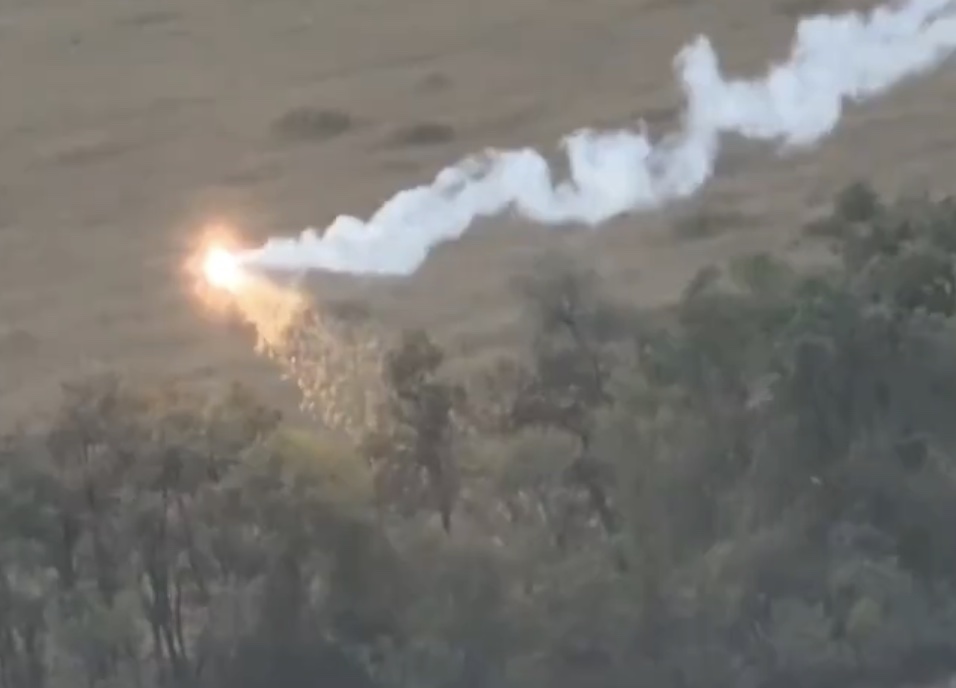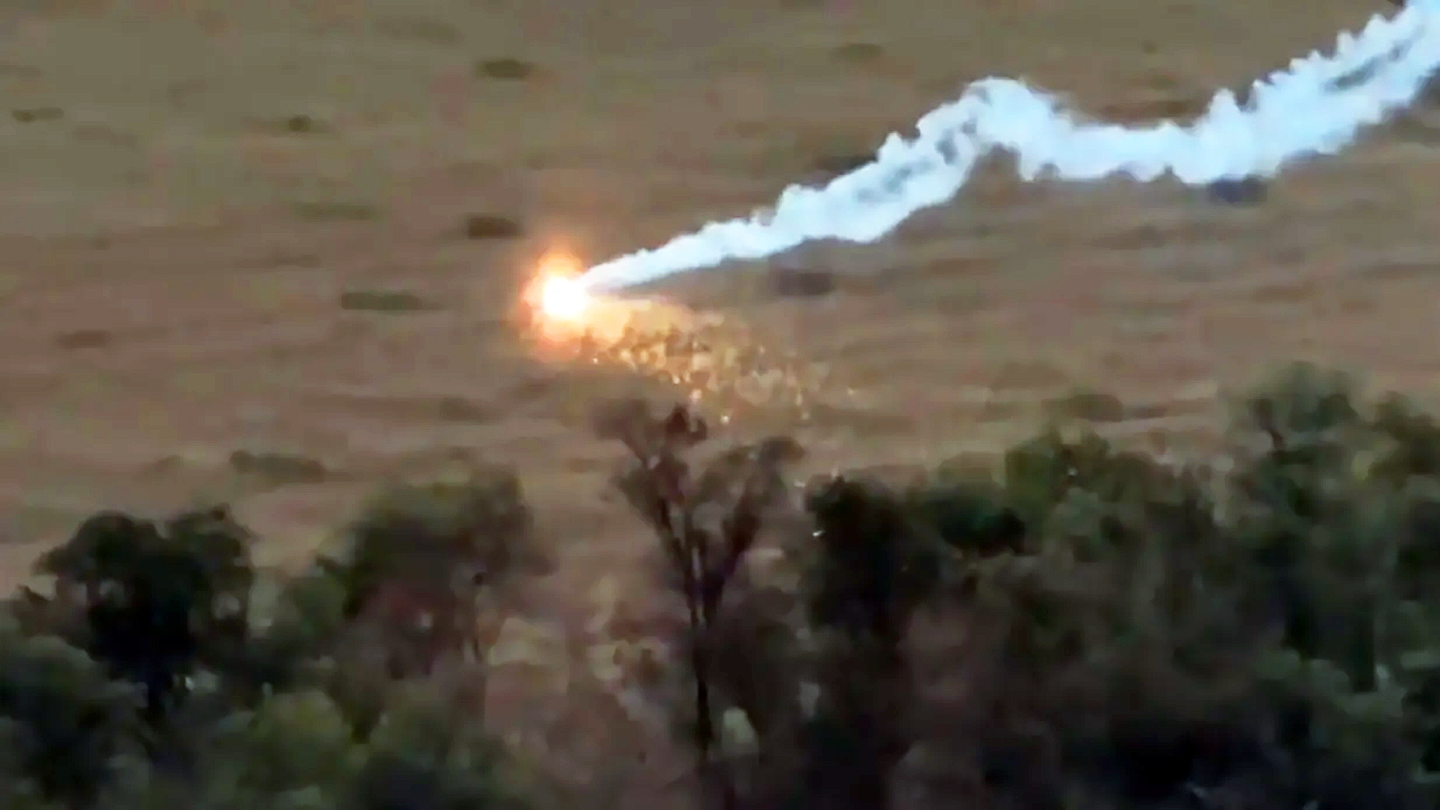Russia has entered the ‘dragon drone’ fray, launching its own thermite-spewing aerial weapons over Ukrainian troops. The development comes about a week after videos first emerged on social media showing Ukraine’s use of these adapted unmanned aerial vehicles over Russian troops ensconced in treelines and trenches.
Thermite, which has primarily been used in grenades and artillery shells, among other applications, is a combination of oxidized iron and aluminum that burns at about 4,440 degrees Fahrenheit. The drones attack by dispersing the compound over treelines and other foliage under which an enemy seeks cover, as well as into trenches. Burning growth away reduces where the enemy can hide, increasing their exposure. By deploying it where troops are hiding, including in trenches, thermite can kill anything exposed. It can also choke off oxygen to and burn those not directly in contact with it.
A video published on Telegram by Moscow politician and military journalist Andrey Medvedev shows Russian troops deploying their dragon drone. It is the first such video to emerge. In it, one soldier is seen attaching a canister purportedly containing thermite to a first-person view (FPV) drone. It is then launched, reportedly toward a Ukrainian position.
The video then shows an operator’s view of the drone over the treeline followed by another drone’s view of it dispensing the burning substance over Ukrainian troops.
“Meanwhile, Russian drone pilots (hooligans, really) from Omut Group are filming the third season of ‘House of the Dragon’ somewhere in the vastness of the” special military operations, Medvedev wrote in a post filled with references to the dragon-lore-loving ‘Game of Thrones’ television series. “A man in a mask plays Prince Daemon Targaryen. A copter with a thermite charge plays the dragon. A Ukrainian stronghold plays the castle of Harrenhal in landing.”
Unlike the Ukrainian dragon drones captured on video, the Russian version emitted mostly a shower of sparks with very little real damage seen.
“Jokes aside, war is increasingly becoming a drone war,” he wrote. “And incendiary drones are getting on video more and more often. At this point, the result of the drone’s work is not very obvious. But in the end, the landing burned out completely. Just as Prince Daemon said. ‘Dreams didn’t make us kings. Dragons did.’”

Russia has a long history of using thermite weapons. In 2012, it fired cluster munitions filled with the compound at targets in Syria. It has also used thermite devices in Ukraine since the early days of the all-out war. You can see one such instance in the following video.
Ukraine had thermite weapons before the dragon drones as well, according to Human Rights Watch.
The organization said it “reviewed visual evidence showing that there were at least 82 attacks in Ukraine using surface-fired incendiary weapons between February 2022 and April 2023.”
Those attacks were spread out across seven Ukrainian regions.
“At this time, it is not possible to attribute responsibility for specific attacks, but Russia and Ukraine both possess the same types of incendiary weapons, including 122mm Grad rockets that deliver incendiary weapons,” the organization stated.
Several Ukrainian Telegram channels bemoaned the new Russian weapon.
“Just another reminder that the enemy learns very quickly!” the Brothers in Arms Telegram channel wrote. Russians “have already copied our Dragon drone and are now burning our positions.”
“The Russians are quickly copying and learning, and the battlefield is increasingly resembling a drone war,” the Sofa Assault Brigade Telegram channel chided.
The following video shows a Ukrainian dragon drone working against a Russian treeline position.
Evidence emerged last week that Russia was tinkering with its own thermite-dropping drone, however, it appeared at the time to offer far more limited battlefield effects
A video posted by the Ukrainian Landmines and Coffee Telegram channel purported to show one such effort. It used “ignition elements from a 120 mm mortar mine,” Landminds and Coffee said. The mortar shells contain thermite.
The 62-second video appeared to show a demonstration of the technology. The drone hovered a few feet off the ground, emitting a torrent of fire and dropping likely thermite-containing submunitions. They created a small fire when hitting the ground. The video, which you can watch below, ended with the drone rising higher before crashing in flames.
This new drone weapon application, now deployed in combat by both sides, differs from previous ones as it provides wide-area effects in a way no other can, while also doing so with incredible precision and no risk to the operator. One drone can do immense damage on a thermite-spewing run, compared to far more limited effects usually associated with small weaponized drones. The psychological angle to this weapon is also substantial.
That Russia is now using dragon drones is no surprise. This war has served as a real-world laboratory for weapons development, especially drones, and each side rapidly learns from the other.
The lessons learned extend far beyond Ukraine. Militaries across the world have taken notice of these new battlefield dynamics and it would not be surprising, either, to see other nations develop their own dragon drones.
Contact the author: howard@thewarzone.com
